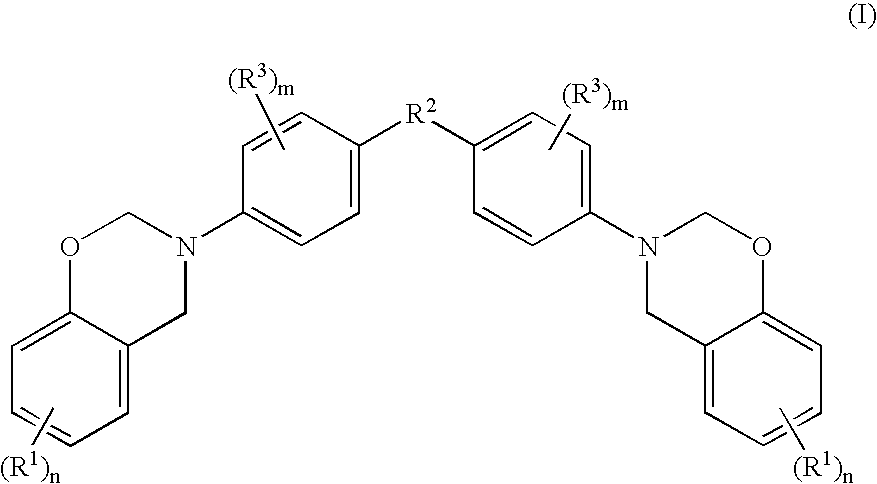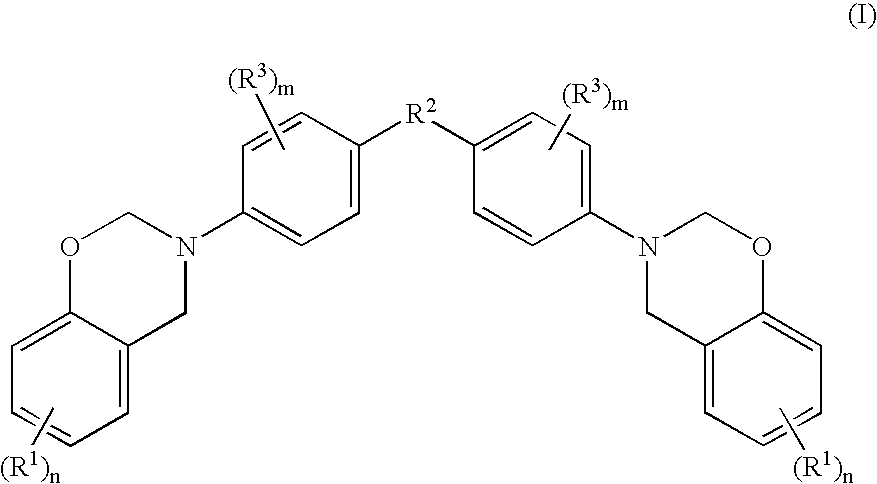Halogen-free resin composition
a technology of halogen-free resin and composition, which is applied in the direction of film/foil adhesive, ink, domestic applications, etc., can solve the problems of serious affecting the health of humans, toxic aniline used in these preparing methods, and the preparation method cannot meet the requirements of mass production in the industry
- Summary
- Abstract
- Description
- Claims
- Application Information
AI Technical Summary
Problems solved by technology
Method used
Image
Examples
synthesis example 1
[0066]216 g of a dried 9,10-dihydro-9-oxa-10-phosphorylphenanthrene-10-oxide (hereinafter is referred to the organic cyclic phosphorus-containing compound, HCA) was charged into a 3000 mL of five-neck glass autoclave equipped with an electrically-heating mantle, a temperature-controlling apparatus, an electrically-driving stirrer, a stirring bar, a thermocouple, a water-cooling condenser and an addition funnel, and then HCA is dissolved by heating under stirring in the glass autoclave. After heated up to 110° C., 112 g of 4-hydroxybenzaldehyde and 940 g of phenol were added. The reaction is conducted for at least 3 hours. Subsequently, the unreacted phenol was recovered. The product was washed with methanol after the reaction had completed. After cooling to room temperature, the product was filtered and dried, and 9,10-dihydro-9-oxa-10-phosphorylphenanthrene-10-oxide-10-yl)-(4-hydroxyphenyl)methanol (hereinafter is referred to the phosphorus-containing compound, HPP) was obtained.
[0...
synthesis example 2
[0068]240 g of dianilinemethane, 228 g of phenol, 156.8 g of 92% paraformaldehyde and 300 g of toluene were successively charged into a 1 L of four-neck reaction vessel equipped with a stirrer, a thermometer, a pressure reducing system, and a condensing-heating mantle. After the reaction system was heated up to 50° C., the electric source for heating was shut. The reaction is conducted for 2.5 hours while maintaining the temperature in the range of 85 and 90° C. after the system released heat Subsequently, in order to recover toluene, the internal pressure was reduced and the temperature was raised. After reaching 130° C. of the temperature and more than 650 mm Hg of the vacuum pressure, and recovering all of toluene, the obtained product was dissolved by adding methyl ethyl ketone, and the synthesis resin B having 60% solid content was obtained.
synthesis example 3
[0069]4000 g (32.7 mol) of 2,6-dimethylphenol, 66 g (1.6 mol) of sodium hydroxide, 429 g (3.3 mol) of dibutylamine, 816 g (8.1 mol) of N,N′-dimethylbutylamine, 20 L of toluene, and 78.5 g (0.35 mol) of copper (II) bromide were charged into a 50 L of stainless steel (SS316) autoclave. Let the oxygen gas flow into the reaction system at the rate of 1 L / min at 38° C. under 1 atm. The polymerization reaction was conducted for 2 hours under stirring at 300 rpm. After the polymerization reaction was completed, the stirring was stopped, the oxygen gas in the reaction system was replaced with the nitrogen gas, and 1600 mL of 1N HCl solution was added into the reaction solution to quench the reaction. 20 L of 1% Na3EDTA was added into the reaction solution and the mixture was stirred for 10 minutes. Then, let the resulting solution stand still to separate off layers. After the aqueous layer was removed, 20 L of deionized water was added into the organic layer, and the mixture was stirred for...
PUM
| Property | Measurement | Unit |
|---|---|---|
| temperature | aaaaa | aaaaa |
| temperature | aaaaa | aaaaa |
| temperature | aaaaa | aaaaa |
Abstract
Description
Claims
Application Information
 Login to View More
Login to View More - R&D
- Intellectual Property
- Life Sciences
- Materials
- Tech Scout
- Unparalleled Data Quality
- Higher Quality Content
- 60% Fewer Hallucinations
Browse by: Latest US Patents, China's latest patents, Technical Efficacy Thesaurus, Application Domain, Technology Topic, Popular Technical Reports.
© 2025 PatSnap. All rights reserved.Legal|Privacy policy|Modern Slavery Act Transparency Statement|Sitemap|About US| Contact US: help@patsnap.com



